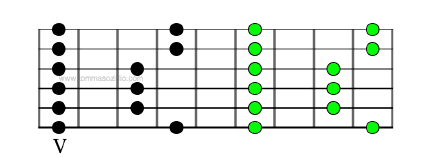Welcome to the second part of this article. If you missed the first part, you can find it here. Now we will explore some other (more advanced) variations of the same sequence we have seen in Part 1. Here is our sequence again:
 <
<
Like Part 1, this article will not make sense unless you take up your guitar and actually try to play the licks. There is no substitution for direct experience! Get your axe and let's dive in.
The last time we have seen how to apply our little sequence to the pentatonic scale. But what if you want to play the blues scale instead of a plain pentatonic? Well, let's lay the blues scale down with 3 notes per strings:
 <
<
Since the blues scale has six notes, the pattern repeats every two strings! This is very comfortable to play (well, OK, it requires a bit of a stretch of the left hand, but I'm sure you can manage it with some practice). Running up and down this shape with our pattern we can build licks like this one (in A):
 <
<
Remember that you can use different rhythmic divisions than sextuplets and you can use both the straight and inverse pattern (or alternate them).
Up to now we have worked only with scales. A whole new world opens up apply our little sequence to arpeggios. The distance between notes (if we are playing them on the same strings) becomes now quite too much for the left hand, so we have to call our right hand in to help with some tapped note. Here's how an Am arpeggio can be played:
 <
<
Notes marked with "T" are tapped notes.
From this point on, point, the sky is the limit: you can apply this to every kind of 3-note arpeggio you can come up with. One example is tabbed here, using the arpeggios of Am and G with tapping on the 1st and 3rd strings. Notice that I'm adding two 'extra' notes on the 3rd string so that the sequence fits the sextuplet pattern.
 <
<
This last one is a very nice-sounding lick, but it is also the most technical lick in this article. The main difficulty here is damping the noise from the other strings. I have prepared a second free video on my web site that shows some tricks that are nearly impossible to explain in writing and will help you play this lick cleaner.
This is a rather advanced concept in general, but some specific examples of it are very easy to understand, so here we go: the left hand plays the standard A minor pentatonic shape (black dots), while the right hand taps the D minor pentatonic scale (green dots).
 <
<
And here's an example lick with this pattern on the first four strings:
 <
<
You can try to apply the same concept to every pair of pentatonic scales. Some of them will sound good, other terrible. Experiment and find the sounds you like. I'll give you more examples of this concept on the free video I have prepared for you.
First of all, do not bother taking all these licks up to speed. Learn the concepts behind them and create your own licks. Here we used only a simple sequence, but you can make up your own. How many licks can you write using a second sequence? How many mixing the two sequences? Try until you hear something that you like. Chances are that when you will find something that you really like, it will be too difficult for you to play at your technical level. Wonderful!
Now it's the moment to sit down and practice to really take care of your technique. Take this one lick that you just created and learn to play it as good as you can. Write it down, so you won't forget it. Then search for another lick that you like. In time, the sum of all these licks that you invented will become your style, your very own recognizable voice.
Tommaso Zillio is a professional prog rock/metal guitarist and composer based in Edmonton, AB, Canada.
Tommaso is currently working on an instrumental CD, and an instructional series on fretboard visualization and exotic scales. He is your go-to guy for any and all music theory-related questions.